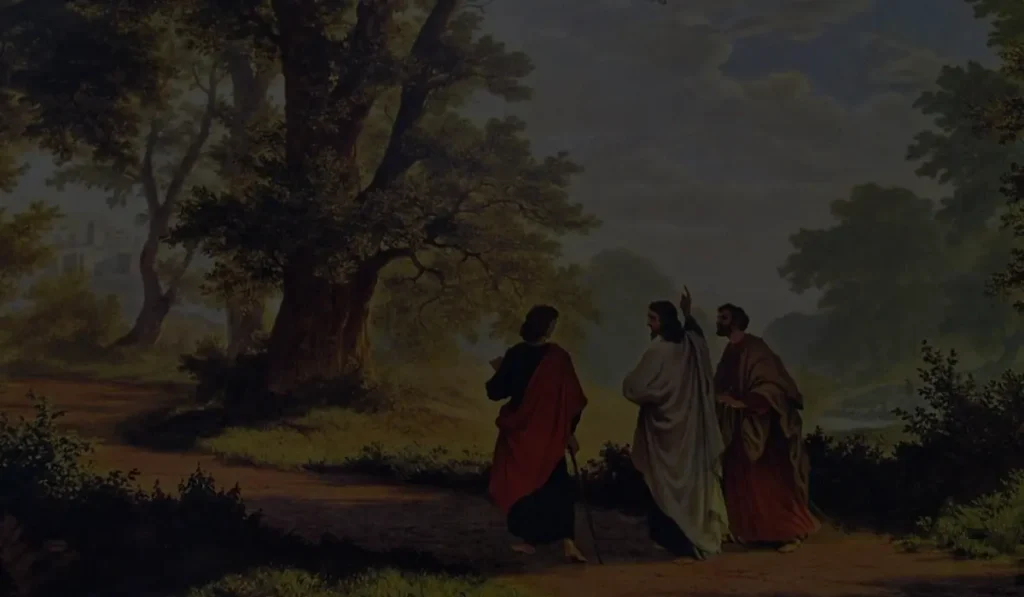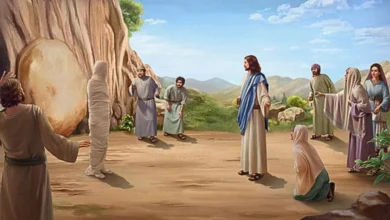Two disciples on the road to Emmaus: who were they?
Two disciples on the road to Emmaus they experienced a transformative encounter with the resurrected Jesus, which became one of the most moving moments recorded in the New Testament.

In the biblical account, these disciples walked sad and discouraged after Jesus' crucifixion.
However, during their journey, an unknown man joined them and began to explain the Scriptures, revealing how all the prophecies pointed to the coming of the Messiah and His resurrection.
It was only when breaking the bread that the disciples recognized that the man was Jesus.
The history of two disciples on the road to Emmaus teaches us about the constant and transforming presence of Jesus in our lives, even in moments of discouragement and uncertainty, get to know us!
Who were the two disciples on the road to Emmaus?
The two disciples on the road to Emmaus are mentioned in the biblical account found in the Gospel of Luke.
Although their names are not specified, we know that one of them was called Cleopas.
These disciples were followers of Jesus and were deeply depressed after the Master's crucifixion and death.
On the way to Emmaus, a village far from Jerusalem, they were engaged in an intense and sad conversation about the events that had happened in the last few days.
How did Jesus' disciples die? This question certainly weighed on their minds as they reflected on recent events.
At that moment, an unknown man joined them.
This man was the resurrected Jesus, although they did not recognize him immediately.
As they walked together, Jesus began to explain the Scriptures and reveal how all the prophecies pointed to the coming of the Messiah and His death and resurrection.
His presence and teachings lit a flame of hope and faith in the hearts of the disciples.
It was only when they arrived at Emmaus that the disciples invited the unknown man to stay with them.
During the meal, Jesus broke the bread and, at that moment, the disciples' eyes opened, and they recognized that they were before the risen Lord.
Jesus washing the disciples' feet it can be seen as a symbolic act that is reflected in the Master's humility and servitude, qualities that again became apparent in that moment of recognition.
Filled with joy and wonder, they shared the news with the other disciples in Jerusalem.
The two disciples on the road to Emmaus represent the experience of many followers of Jesus throughout history.
What was the road to Emmaus?
The road to Emmaus was a road that connected Jerusalem to the village of Emmaus, located about 11 kilometers away.
This road was known as the “road to Emmaus” because of the final destination of the journey.
In the biblical context, the road to Emmaus became significant because of the extraordinary encounter that occurred on it.
It was on this road that two of Jesus' disciples were walking and talking after Jesus' crucifixion and death.
They were discouraged and sad, discussing recent events. As they walked the road to Emmaus, the resurrected Jesus joined them, although they did not immediately recognize him.
It was during this walk that Jesus shared teachings, explaining the Scriptures and revealing how all the prophecies were fulfilled in His death and resurrection.
The road to Emmaus became an emblematic place where a profound and transformative encounter with the risen Lord took place.
It symbolizes the journey of faith, where we often walk with discouraged and uncertain hearts, but encounter Jesus himself along the way.
It is a reminder that even in the most difficult times, He is present and willing to walk alongside us, open our eyes to the truth and renew our hope.
Who were the Emmaus?
Emmaus was a village located about 11 kilometers from Jerusalem, mentioned in the biblical account of Jesus' encounter with the two disciples on the road to Emmaus.
Although we don't have many details about this village in the Bible, it is possible that it was a rural community or a stop along the road that connected Jerusalem to other regions.
The name “Emmaus” may have different meanings in different languages, but the exact meaning is unclear.
In the biblical context, Emmaus became an emblematic place due to the remarkable encounter that took place there.
It was in this village that the resurrected Jesus shared teachings and revealed himself to his disciples as they shared a meal.
Nowadays, the exact location of Emmaus is uncertain, and different traditions and theories point to possible locations.
However, regardless of its precise location, the story of the disciples of Emmaus teaches us about the constant and transforming presence of Jesus in our lives, even in moments of discouragement and uncertainty.
In which region was the city of Emmaus located?
The exact location of the city of Emmaus mentioned in the biblical account is not clearly identified, which has led to various theories and interpretations.
Some scholars suggest that Emmaus could be identified with a village called Emmaus Nicopolis,
located in the Judea region, about 30 kilometers west of Jerusalem.
Another possibility is that Emmaus was a different village, located in another part of the Judean region or even in an area close to Galilee.
However, the lack of concrete archaeological and historical evidence makes it difficult to determine the precise location of Emmaus with certainty.
Regardless, the story of the disciples of Emmaus highlights the importance of this transformative encounter with the resurrected Jesus, regardless of the city's specific geographic location.
FAQ – (Frequently Asked Questions)
“What happened on the road to Emmaus?“
On the road to Emmaus, as described in the Gospel of Luke (24:13-35), two disciples encounter a stranger (Jesus, initially unrecognized) who accompanies them.
They talk about recent events in Jerusalem (the crucifixion and resurrection of Jesus) and Jesus explains the Scriptures to them.
Only when they sit down to eat together do they recognize Jesus, who immediately disappears from their sight.
“Who were the disciples on the road to Emmaus?”
One of the disciples is identified as Cleopas (Luke 24:18).
The other disciple is not named in the biblical story.
They were not among the twelve apostles, but they were followers of Jesus.
“Why didn’t the disciples recognize Jesus on the road to Emmaus?”
Scripture suggests that the disciples’ eyes were “prevented” from recognizing Jesus (Luke 24:16).
This could be a divine act to conceal Jesus' identity until the right time, or it could be due to the fact that they simply did not expect to see Jesus after his death and resurrection.
“How important is the story of the disciples on the road to Emmaus?”
The story of the disciples on the road to Emmaus is a demonstration of the fact that Jesus is present even when we don't recognize him.
It also illustrates how understanding the Scriptures can open our eyes to the presence and action of Jesus in our lives.
“How did the disciples react when they recognized Jesus?”
When the disciples recognized Jesus, he disappeared from their sight.
In response, they reflected on how their hearts burned as he explained the Scriptures to them.
They then returned to Jerusalem to tell the other disciples about their encounter with Jesus.




